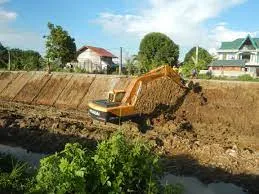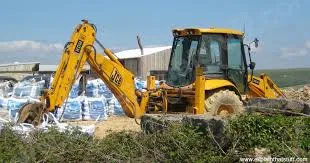Definition: Slope protection refers to a variety of techniques employed to stabilize slopes and prevent erosion.
Click the Translate button(see right) on this post to set your Own Language to understand more perfectly!!
Slope Protection Calculator
Continue Definition:
Slope Protection
Slope protection refers to a variety of techniques employed to stabilize slopes and prevent erosion.
These techniques address various threats, including:
Soil erosion: Rain, wind, and other elements can wear away soil particles on a slope, leading to instability and potential landslides.
Landslides: Unstable slopes can collapse entirely, causing significant damage and safety hazards.
Weathering: Harsh weather conditions can break down rocks and soil on a slope, accelerating erosion.
Properties of Effective Slope Protection:
Stability: The chosen method should effectively reinforce the slope and prevent movement.
Durability: The materials used must withstand weathering and environmental factors for a long lifespan.
Erosion resistance: The technique should be able to handle water flow and prevent soil loss.
Cost-effectiveness: The chosen solution should be cost-efficient considering installation, maintenance, and longevity.
Aesthetics: In some cases, visual appeal might be a factor, especially for slopes in public areas.
Supporting Equation (Slope Stability Analysis):
Geotechnical engineers use slope stability analysis to evaluate a slope's stability and determine the need for protection. One common method uses the infinite slope model, which analyzes forces acting on a potential sliding soil mass.
The equation for this model is:
FS = (Shear Strength) / (Driving Shear Stress)
Where:
FS is the Factor of Safety (a value greater than 1 indicates stability).
Shear Strength is the soil's resistance to sliding.
Driving Shear Stress is the force pushing the soil mass down the slope (gravity and other factors).
Example: Reinforced Vegetation
One common slope protection technique is vegetation reinforcement. This method involves planting grasses, shrubs, or other vegetation with strong root systems that bind the soil particles together. Vegetation also helps with drainage, reducing water infiltration that can weaken the slope.
This method is often used for gentle slopes and offers the benefit of aesthetics and habitat creation. However, it might not be suitable for steep slopes or areas with harsh weather conditions.
Here are the merits and demerits of using a Slope Protection Calculator:
Merits:
1. **Accuracy:** Slope Protection Calculators utilize mathematical models and algorithms to determine the stability and safety of slopes. They provide accurate predictions of factors such as factor of safety, erosion potential, and stability analysis, helping engineers make informed decisions.
2. **Efficiency:** Calculating slope protection measures manually can be time-consuming and prone to errors. Slope Protection Calculators automate the process, saving time and effort for engineers and designers. They streamline the analysis and design process, allowing for quicker project completion.
3. **Customization:** Many Slope Protection Calculators offer options for customization based on project-specific parameters such as soil type, slope geometry, rainfall intensity, and design requirements. This flexibility allows engineers to tailor slope protection measures to meet the unique needs of each project.
4. **Risk Assessment:** Slope Protection Calculators help assess the risks associated with slope instability, erosion, and potential failure. By analyzing various scenarios and factors, engineers can identify vulnerable areas and implement appropriate protection measures to mitigate risks effectively.
5. **Cost-Effectiveness:** By optimizing slope protection measures, these calculators can help reduce construction costs while ensuring adequate stability and safety. Engineers can compare different protection options and select the most cost-effective solution without compromising on performance.
Demerits:
1. **Assumption Limitations:** Slope Protection Calculators rely on certain assumptions and simplifications in their mathematical models. These assumptions may not always accurately represent real-world conditions, leading to potential discrepancies between calculated results and actual performance.
2. **Data Requirements:** Accurate slope protection analysis requires input data such as soil properties, rainfall data, slope geometry, and site conditions. Obtaining reliable data can be challenging, especially for remote or inaccessible project sites, which may affect the accuracy of the analysis.
3. **Expertise Required:** While Slope Protection Calculators automate many aspects of the analysis and design process, they still require a certain level of engineering expertise to interpret results correctly and make informed decisions. Misinterpretation of results or improper application of protection measures can lead to ineffective solutions or safety risks.
4. **Limited Scope:** Slope Protection Calculators typically focus on specific types of protection measures or failure mechanisms, such as erosion control, slope stabilization, or landslide prevention. They may not cover all potential hazards or design scenarios, limiting their applicability in certain situations.
5. **Software Dependency:** Slope Protection Calculators are often software-based tools that rely on computer programs or applications. Dependency on software platforms introduces the risk of compatibility issues, software updates, and potential obsolescence, which may impact long-term usability and maintenance.
In summary, Slope Protection Calculators offer numerous benefits in terms of accuracy, efficiency, customization, risk assessment, and cost-effectiveness. However, they also have limitations related to assumptions, data requirements, expertise, scope, and software dependency, which engineers should consider when utilizing these tools for slope protection analysis and design.
Do YOU Want To Earn Money In Various Ways, Click The Link & Explore Your Field of Interest!!!
































